The Isle of Gigha, just north of the Mull of Kintyre, was our last stop in Scotland. After an early monrning run from Oban, we stopped at Gigha for two nights to wait for a storm system to pass through before continuing south to Ireland. While there we installed the new Rule 3700 bilge pump since we now had all the parts we needed.
Below are trip highlights from October 21st and 22nd, 2017 in southwest Scotland. Click any image for a larger view, or click the position to view the location on a map. And a live map of our current route and most recent log entries always is available at http://mvdirona.com/maps
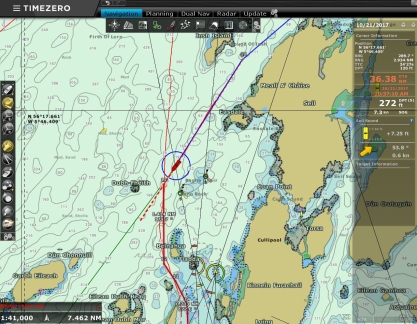 |
Crossing Our Path
Position: -5 41.18, 56 16.91
We’re just about to cross our path from two months ago between the Crinan Canal and Loch Spelve. We’re also about to pass through the narrows into the Sound of Luing as we did before heading northbound, except this time it’s 5:44am and pitch black outside. We left Oban at 4am this morning in order to pass through the narrows at slack and ride the flood current heading south.
|
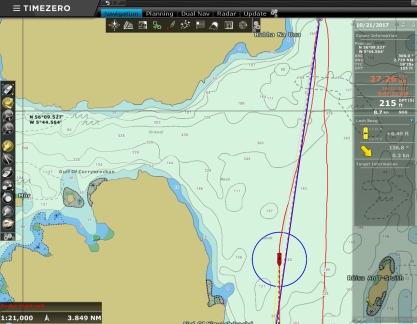 |
Gulf of Corryvreckan
Position: -5 40.27, 56 8.52
We typically run with our autopilot in NAV mode, which essentially asks the autopilot to steer to a plotted route rather than just in a specific direction. The blue line is our plotted course and the left red line is our actual course. (The right red line is our path north from the Crinan Canal two months earlier.) Normally our actual course follows the plotted course almost exactly, but here we’re tracking badly due to strong tidal streams in the Gulf of Corryvreckan to our west. We’re on a spring tide, where 8.5-knot currents generate hazardous whirlpools and overfalls. When a west-bound current meets an opposing large Atlantic swell, conditions make the passage nearly impassable.
|
 |
Speed
Position: -5 41.60, 56 4.52
We’ve got some daylight and a little positive current now. We’re making 9.0 knots, close to our top speed of 9.5 knots, when normally we’d be doing about 8 knots at 1766 RPM.
|
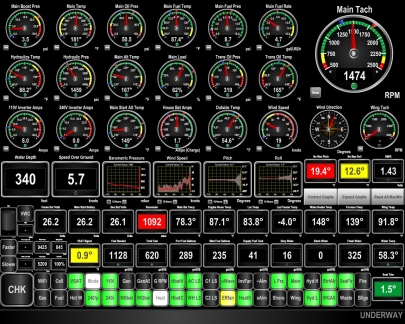 |
Pitching
Position: -5 45.28, 55 53.75
We’d planned to spend a couple of nights at the Isle of Gigha while a weather system passed through before we continue on to Belfast. As we expected, the winds were just starting to pick from the southeast as we passed the mouth of Loch Sween. (Our weather station failed shortly before this screen shot was taken, so neither the wind nor the barometer data are accurate). Where the Sound of Jura meets Loch Sween, the combined strength there of the outgoing tides against 20 knots of winds generated large and tight waves. The charts warn that these conditions can be dangerous for small craft, and we’re pitching nearly twenty degrees as we pass through.
|
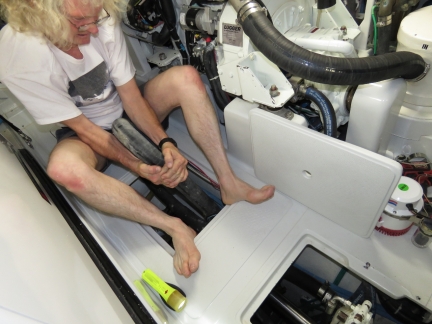 |
Bilge Pump Hose
Position: -5 43.48, 55 41.49
Safely anchored at the Isle of Gigha, James set to work on installing the new bilge pump. Here James is pulling up the extremely stiff hose from the manual bilge pump that we’ll use as the discharge hose for the new pump.
|
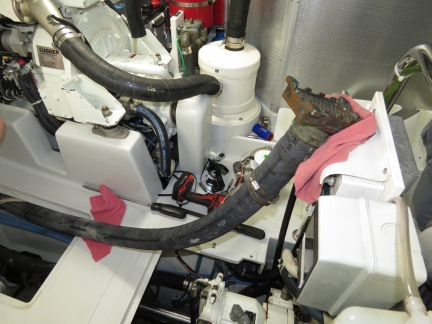 |
Hose Out
Position: -5 43.48, 55 41.49
After much effort, we finally got the manual bilge pump hose out of it’s installed position in the bilge. What you can see here is the grate at the end of the hose where it picks up from the bottom of the bilge. Due to tight quarters in the main bilge, the design we have taken is have the new bilge pump share the 2-inch manual bilge pump hose. It’s an unusual configuration, but we’ve tested both the manual bilge pump and the new Rule 3700 in this configuration and they both work well without noticeable loss of volume.
|
 |
Bilge Pump in a Bottle
Position: -5 43.48, 55 41.48
The main bilge is actually too small to slide in the new Rule 3700 even without plumbing. With five through-hulls bringing in raw water and the main prop shaft in the way, the new pump can’t just be lowered into the bilge. But, with the through-hull handles set to closed and the strainer removed from the bilge pump, it can be worked into place. But this means that the float switch, strainer, and plumbing need to all be added in at the bottom of the bilge. We need to build the assembly in place like a ship in a bottle.
|
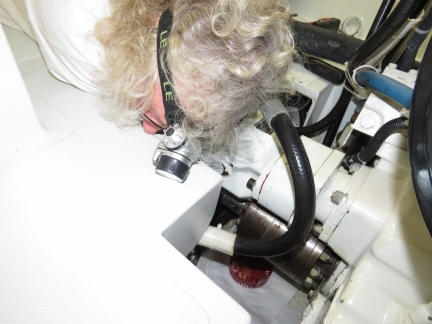 |
Working by Feel
Position: -5 43.48, 55 41.49
It’s hard to see what James is doing here, but he’s lying face down with each arm down into the bilge holding the pump in one hand and installing parts with the other hand. It’s good that he can get both arms down, but he has to work blind since there is no angle that allows him to see while at the same time having both arms in deeply enough to access the pump just below the five sea water through-hulls.
|
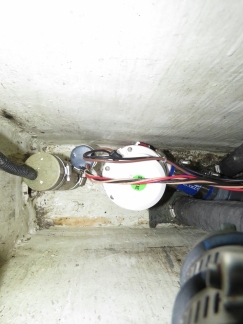 |
Pump Installed
Position: -5 43.48, 55 41.49
Aside from the difficulty of getting the system plumbed in, this picture shows that everything actually fits quite nicely. Even better, in testing, the new pump really empties that bilge quickly.
|
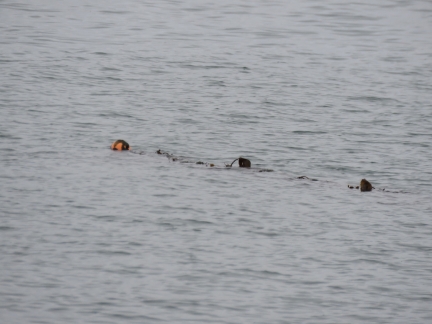 |
Fishing Floats
Position: -5 43.46, 55 41.49
While we were working on the bilge pump, a fish boat dropped a series of floats near our anchorage. They’re not very easy to see, and we’ll be leaving in the dark for Belfast in a couple of days.
|
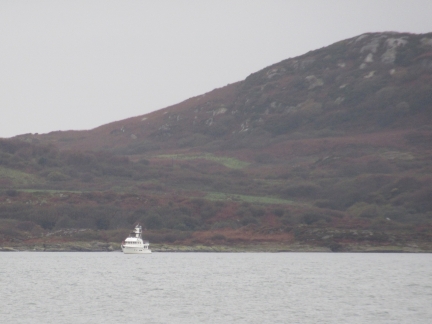 |
Isle of Gigha
Position: -5 43.48, 55 41.49
Neil White took this photo of Dirona at anchor at the Isle of Gigha as he passed by in the Glen Tarsan en route to Campbeltown around the Mull of Kintyre .
|
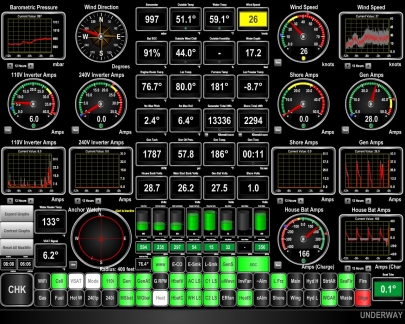 |
Wind
Position: -5 43.39, 55 41.47
We’d planned to stop at the Isle of Gigha for a couple of nights while a storm system passed through. Winds were from the southeast when we arrived, and the anchorage was surprisingly well-protected from that direction. But the bigger winds that we were expecting would be coming from the west, where we’d be completely sheltered behind the island. And that’s how it turned out. Winds have been steadily in the high 20s and 30s from the west, with gusts over 40 kts. Gigha was an excellent anchorage for these conditions, and a good jumping off point to reach Belfast once conditions had settled.
|
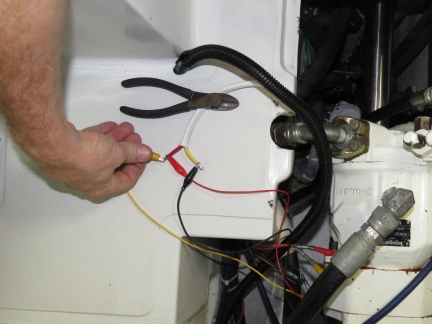 |
Testing
Position: -5 43.39, 55 41.46
In addition to installing the new Rule 3700, we also wanted the ability to control the pump manually and to sense when it was on and pumping, whether automatically or manually. Here James is testing that circuit.
|
 |
Switch
Position: -5 43.39, 55 41.47
We installed a new switch box to 1) allow manual operation of the new Rule 3700 bilge pump, 2) show a red LED when the bilge pump is operating and 3) to house a relay that signals when the pump is on that we will read from one of our Raspberry Pis.
|
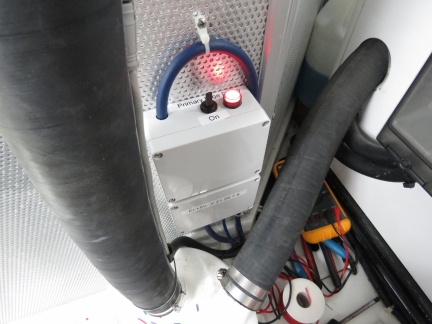 |
Switch Complete
Position: -5 43.39, 55 41.47
We can now flip a switch to manually turn on the new pump, and if the pump is on, a red indicator light will display and a relay will close.
|
 |
Sensor
Position: -5 43.39, 55 41.47
With the hardware changes complete, the next step is to integrate the pump into our alerting system. Here James is programming one of our Raspberry Pis to sense when the pump is on and feed that information into our control systems.
|
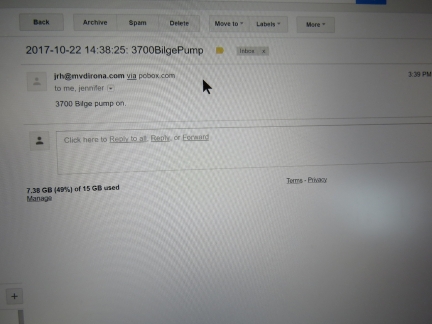 |
Bilge Pump Alert
Position: -5 43.39, 55 41.47
When the new primary bilge pump, the Rule 3700, operates, the control system will send email, generate an audible alarm, and display an indicator light on our Maretron N2kView display.
|
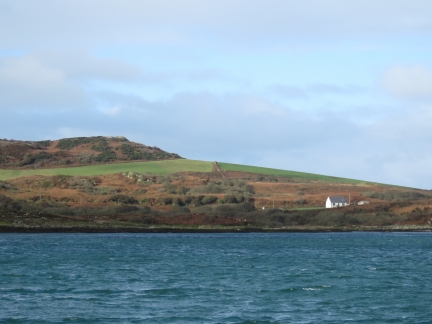 |
Isle of Gigha
Position: -5 43.39, 55 41.46
The hills on the Isle of Gigha behind our anchorage are giving us good wind protection.
|

|
Click the travel log icon on the left to see these locations on a map, with the complete log of our cruise.
On the map page, clicking on a camera or text icon will display a picture and/or log entry for that location, and clicking on the smaller icons along the route will display latitude, longitude and other navigation data for that location. And a live map of our current route and most recent log entries always is available at http://mvdirona.com/maps. |

Hi James and Jennifer. I wanted to wish you a Merry Christmas and a thanks for allowing us to share in your journey this past year. Despite the harrowing moments you have shared some amazing adventures. Best wishes for the new year ahead and may you always find calm seas.
99% excellent times. We feel super lucky to be on this crazy trip. Thanks for the support Stewart.